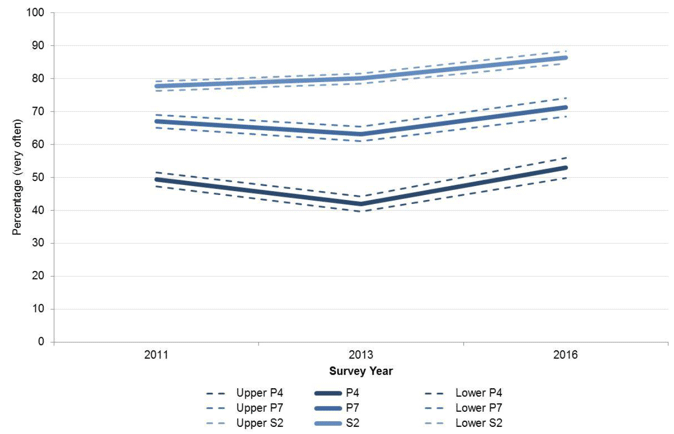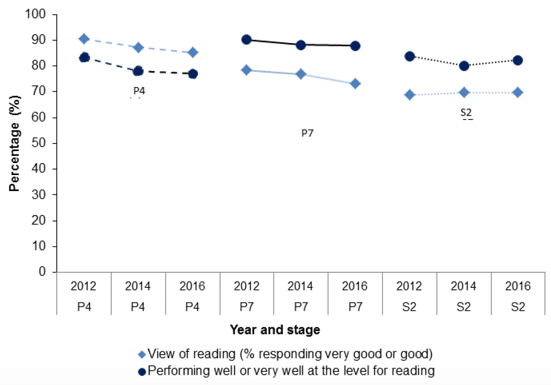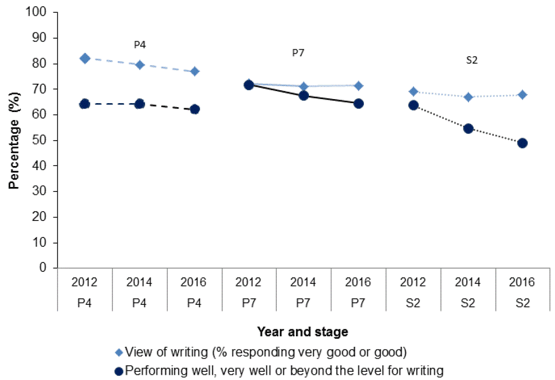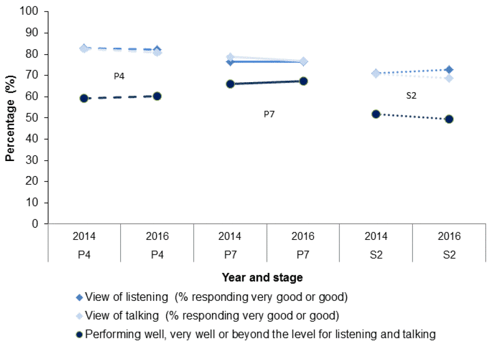Scottish Survey of Literacy and Numeracy 2016: literacy
Literacy results from the 2016 survey which covers assessment of school pupils at various stages in primary and secondary school.
Chapter 8: Pupil questionnaire
- The majority of pupils (94 per cent and over) agreed they wanted to do well in their learning and felt they usually did well at school, in each of the six surveys.
- Over 65 per cent of pupils reported that someone at home asked them what they did at school very often and told them that working hard at school is important, in each of the six surveys.
- In 2016, S2 pupils were more likely to read on electronic devices and use the internet outside of school compared to primary pupils. S2 pupils also reported having the highest confidence using ICT to do school work.
All pupils participating in the SSLN were asked to complete an online questionnaire. The questionnaire focused on factors that are likely to affect learning, such as pupil attitudes and experiences in class. It should be noted that: 'don't know' responses were removed prior to analysis unless otherwise stated; and where 'agreed' is used this refers to pupils who responded either 'agree a lot' or 'agree a little'.
8.1 Attitudes to learning - classroom activities
Pupils were asked how often they participated in a range of activities in the classroom. 'Listen to the teacher talk to the class about a topic' has consistently been the most common activity for P4 and S2 pupils over the six SSLN surveys. For P7, this was highest for five years out of six (in 2012 the most common activity was 'Discuss what you are learning'). In 2016, around two thirds of pupils stated they 'listened to the teacher talk to the class about a topic' 'very often' (64, 67 and 69 per cent in P4, P7 and S2 respectively).
Similarly the second most common activity across all six survey years for P4 and S2 pupils was consistently 'Working on your own' (58 per cent for P4; 57 per cent for S2 in 2016). For P7 pupils, however, the second most common activity was generally 'Discuss what you are learning' (61 per cent in 2016), with 'Working on your own' generally the third most common.
At primary stages, the biggest reported increase between 2011 and 2016 was 'Working through a book or a worksheet on your own'. For P4 and P7 this has increased by 10 and 11 percentage points to 47 and 49 per cent respectively. At S2, more pupils are reporting they 'Work with other pupils', an increase from 24 to 32 per cent.
The biggest decrease in classroom activities was using computers for P4 and P7 between 2011 and 2016. The proportion of P4 pupils stating they used computers in the classroom 'very often' decreased from 34 to 28 per cent and for P7 decreased from 38 to 31 per cent.
8.2 Attitudes to learning and literacy
Pupils were asked how much they agreed with a series of statements related to attitudes to learning, two examples of which are shown in Tables 8.1 and Table 8.2. The results over the six years show engagement with learning has been consistently high. The tables show the proportion of pupils agreeing with such statements tended to be around, or higher than, 90 per cent. There has been some fluctuation but no more than three percentage points over the six years.
Table 8.1: Proportion of pupils who 'agree a lot or a little' to the statement 'I want to do well in my learning'
| Stage |
2011 |
2012 |
2013 |
2014 |
2015 |
2016 |
|---|---|---|---|---|---|---|
| P4 |
97 |
97 |
98 |
96 |
97 |
96 |
| P7 |
98 |
98 |
98 |
98 |
98 |
97 |
| S2 |
97 |
97 |
97 |
96 |
97 |
96 |
Table 8.2: Proportion of pupils who 'agree a lot or a little' to the statement 'I try to find out the answers on my own'
| Stage |
2011 |
2012 |
2013 |
2014 |
2015 |
2016 |
|---|---|---|---|---|---|---|
| P4 |
96 |
96 |
97 |
95 |
96 |
94 |
| P7 |
96 |
97 |
96 |
95 |
96 |
96 |
| S2 |
92 |
93 |
94 |
93 |
93 |
93 |
The percentage of pupils who agreed a lot or a little with the statement 'I don't like learning' was 15 per cent for P4, 16 per cent for P7 and 21 per cent for S2 in 2016. There was no significant difference for P7 and S2 to 2011 reported results, whereas there was a small increase of four percentage points for P4.
The biggest disparity between stages was in relation to the statement that 'Learning is boring'. In 2016, 40 per cent of S2 pupils agreed with this statement, compared to 25 per cent at P7 and 16 per cent at P4. Across all six survey years, the S2 rate has always been at least double that of P4.
Pupils have consistently agreed that what they are learning in class was useful outside school, with over 90 per cent of primary and over 80 per cent of secondary pupils in agreement. This consistency can also be seen when P7 and S2 pupils are asked about how learning affects their future. Across all surveys, the vast majority agreed with the following statement 'I learn many things at school that will help me get a job.' and 'What I learn is important because I need it for what I want to study later on'.
In literacy years (2012, 2014 and 2016) pupils were asked about their attitude to aspects of literacy.
In 2016, pupils at all stages agreed most positively to the statement 'I enjoy reading'. P4 was highest with 89 per cent, followed by P7 at 78 per cent and 61 per cent for S2. This was consistent over all three surveys, with only a small change in proportion from the 2016 figures (less than three percentage points).
P4 pupils were more positive about talking to other people about things that they have read. This is shown in Chart 8.1, for each survey P4 pupils are 1.5 times more positive than S2 pupils.
Chart 8.1: Proportion of pupils who 'agree a lot or a little' with the statement 'I like talking to other people about things I have read' by stage in 2012, 2014, and 2016

Around a third of primary pupils in all three surveys agreed that they only read 'in school or for homework'. This was higher in S2, ranging between 47 to 50 per cent, which ties in with around 45 per cent of S2 pupils who think reading was boring.
8.3 Pupil engagement with teachers and parents/carers
Pupils were also asked about teachers' practices in the classroom. The most common practices being undertaken 'very often' were 'Telling you what you are going to learn about before you start working' (81, 89 and 73 per cent at P4, P7 and S2, respectively). In the last six surveys this has been the highest reported teacher practice by the pupils at all stages, with primary sectors consistently over 80 per cent and S2 over 70 per cent.
A similar pattern can be seen for 'Encouraging you to work hard', over the six surveys this has the second highest rates recorded, with P7 consistently over 80 per cent; P4 ranging between 67 and 75 per cent and S2 between 64 and 68 per cent of pupils reporting teachers did this 'very often'.
More than two-fifths of pupils reported that teachers in the primary sector explained to pupils how they would know when they have done well very often. This has been consistent over the six surveys. This tended to be lower for S2 pupils (between 28 to 30 per cent).
Pupils were also asked how often someone at school talked to them about their learning. For all stages, this has increased between 2011 and 2016. For P4 this was an increase of eight percentage points, four at P7 and three at S2. In 2016, the percentage of pupils who reported this happening very often was 34, 27 and 18 per cent (P4, P7 and S2 respectively). Over half of all pupils for all stages in 2016 reported that someone talks to them about their learning 'sometimes', and over a quarter of secondary pupils reporting 'hardly ever or never'.
The extent of engagement in the home has been constant since 2011. In all the surveys, pupils have been asked how often does someone at home:
- ask you what you did in school
- help you with your homework if you need help
- tell you that working hard at school is important.
Generally, at least half of pupils have reported that someone at home engages with them about school 'very often'.
In 2016, P7 pupils tended to respond more positively to the question 'How often someone asked you what you did at school' (78 per cent responded 'very often') compared with P4 and S2 (both 71 per cent). For the primary sector, there was no change between 2011 and 2016 but there was an increase of four percentage points at S2. So by 2016, seven out ten pupils had someone at home regularly asking them what they did in school.
In 2016, at all stages 'How often does someone at home help you with your homework' was least prevalent compared to the other two statements. The highest proportion of pupils responding 'very often' was P7 pupils at 65 per cent, followed by S2 at 59 per cent and P4 at 53 per cent.
In 2016, 77 per cent of P7 and S2 pupils reported that someone at home told them school was important 'very often' (65 per cent at P4). For P7 and S2 there has been no significant change in responses to this question between 2011 and 2016, for P4 there was a slight decrease of four percentage points in those saying this happens very often.
Some new questions were asked of P4 pupils in the 2016 survey on how often someone at home encouraged activities that promote literacy and numeracy skills. Playing games together that use numbers or counting was the most popular with 78 per cent reporting this happened very often or sometimes. Someone at home was more likely to read with a P4 pupil (38 per cent reported this activity as very often) than play words games (30 per cent).
Chart 8.2: Proportion of P4 pupils who had someone a home who…..

8.4 Activities in and out of school
Since 2015, the SSLN pupil questionnaire has been modular in design. The 2016 modules were Activities Outside of School (last asked in 2014) and Use of Information and Communication Technology ( ICT) in school (last asked in 2015). In 2015, a module on Behaviour in School was also asked.
In 2016, some new questions were introduced into the Activities Outside of School module. For example, all pupils were asked if they 'Go to a library or mobile library' outside of school time. There was a five percentage point difference between pupils of each stage who responded 'very often' to this question (20, 15 and 10 per cent for P4, P7 and S2 respectively). P4 pupils were also asked how often they tell the time outside school and how often they write or type. Around half selected 'very often' for telling the time and around a third for write or type.
In 2016, it was the first time pupils were asked about reading information on electronic devices such as tablets, Kindles, phones etc. S2 pupils saw the highest percentage of all the stages with 40 per cent reporting that they did this 'very often'. In terms of the range of reading undertaken, S2 pupils were more likely to read online (31 per cent) and read directions/instructions (26 per cent) than novels (22 per cent) or reference books (14 per cent). Primary pupils were more likely to read novels for enjoyment (44 and 33 per cent of P4 and P7 pupils respectively).
Table 8.3: Proportion of pupils who responded 'very often' to the statements: (ordered by S2 response).
| P4 (%) |
P7 (%) |
S2 (%) |
|
|---|---|---|---|
| I read using an electronic device (for example, a Kindle, a tablet or a smart phone). |
33 |
30 |
40 |
| I read online (for example, web pages or blogs). |
21 |
25 |
31 |
| I read directions or instructions (for example, to learn how to play a game or download music) 1. |
- |
32 |
26 |
| I read storybooks (novels) for enjoyment. |
44 |
33 |
22 |
| I read books that explain things (for example, books about your favourite sports person or animals). |
38 |
25 |
14 |
| I read magazines 1. |
- |
18 |
12 |
| I read comics for enjoyment. |
27 |
17 |
12 |
| I read newspapers 1. |
- |
8 |
8 |
1P4 pupils not asked this question.
The most popular activities outside of school, as reported by primary pupils over five survey years, were 'I play or talk with friends' or 'I play sports'. P4 pupils reported over 70 per cent played and talked to friends 'very often' whereas for P7 pupils this was nearly 80 per cent. Between 62 and 66 per cent of primary pupils reported they played sports very often over the five years. For S2 these were also the most popular choices with over 70 per cent of pupils that played or talked with friends, though responses to playing sports was lower than primary pupils ranging from 51 to 53 per cent.
Some of the questions have been asked in three surveys (2011, 2013, and 2016) and the results for 'I use the internet' outside of school was different for each stage (Chart 8.3). For all stages the internet usage has increased between 2011 and 2016.
Chart 8.3 Proportion of pupils who use the internet 'very often' by stage in 2011, 2013 and 2016

Note: Confidence intervals are denoted by dashed lines around the mean estimate (solid line).
The proportion of pupils who report watching television and DVDs has declined between 2011 and 2016 for all three stages to around a third of P4 and S2 pupils and to about a quarter of P7 pupils. This may be due to the increase in television and film content being viewed or streamed online, following the growth of the availability of these services since the beginning of the decade.
In 2015 and 2016, pupils were asked about their use of ICT in general (both in classroom and at home) to assist with literacy and/or numeracy. In 2016, P7 and S2 pupils were most likely to use computers, tablets, etc. to do topic or project work. Half of P7 pupils (53 per cent) and 45 per cent of S2 pupils reported they did this 'very often'. The highest reported use of ICT by P4 pupils was completing work on their own (50 per cent). Over a third of all pupils in both surveys reported using computer/tablets 'very often' to do their homework.
In 2016, S2 pupils reported that they were most confident using ICT to find out information/carry out research and for typing or editing work (95 and 93 per cent respectively). A lower proportion of pupils across all stages reported they were confident creating tables and charts: 72, 75, 78 per cent (P4, P7 and S2 respectively).
When pupils were asked about their attitudes to using ICT, there was no significant difference between the results in 2015 and 2016 apart from P7 pupils. There was a slight increase from 16 to 19 per cent who agreed that they find tasks using a computer/tablet hard. In 2016, P7 pupils were the least likely to find working with ICT boring in school at 13 per cent (18 and 23 per cent for P4 and S2 respectively). In both 2015 and 2016 and at all stages, over 90 per cent of pupils agreed that they enjoy doing school work on the computer and usually do well in these tasks.
8.5 Links between attitudes and attainment
The results showed evidence of a difference between pupils' views on their ability in literacy and their actual performance in the SSLN. Chart 8.4 illustrates the difference between pupils' views on their reading ability (proportion of pupils who though they were good or very good) and the assessment results (proportion of pupils who performed well or very well in reading).
Over the three literacy surveys, P4 pupils viewed their ability more positively in reading than P7 and S2. P4 pupils also rated their ability higher than their assessment results would suggest, though this was not the case for P7 and S2 pupils.
Chart 8.4: Difference between pupils' views on their reading ability and performance, by stage and year

In writing, pupils from all stages viewed their ability higher than the writing results would indicate (Chart 8.5); with the smallest discrepancy at P7. Pupils' attitudes towards their writing ability have stayed relatively stable over the three surveys for each stage, with the biggest decrease being five percentage points at P4 between 2012 and 2016.
Pupils were asked to rate their ability in their listening skills independently from talking. They mapped very closely to each other (Chart 8.6), apart from S2 in 2016 where pupils rated their ability in listening higher than that of talking (four percentage points). Similar to writing, all pupils viewed their ability higher than the listening and talking results would suggest. In all six surveys, pupils were very positive in their attitude to learning, it is only P7 and S2 reading where pupil's performance exceeds perceived ability.
Chart 8.5: Difference between pupils' views on their writing ability and performance, by stage and year

Chart 8.6: Difference between pupils' views on their listening and talking ability and performance, by stage and year

Contact
Email: Marion MacRury
Phone: 0300 244 4000 – Central Enquiry Unit
The Scottish Government
St Andrew's House
Regent Road
Edinburgh
EH1 3DG
There is a problem
Thanks for your feedback